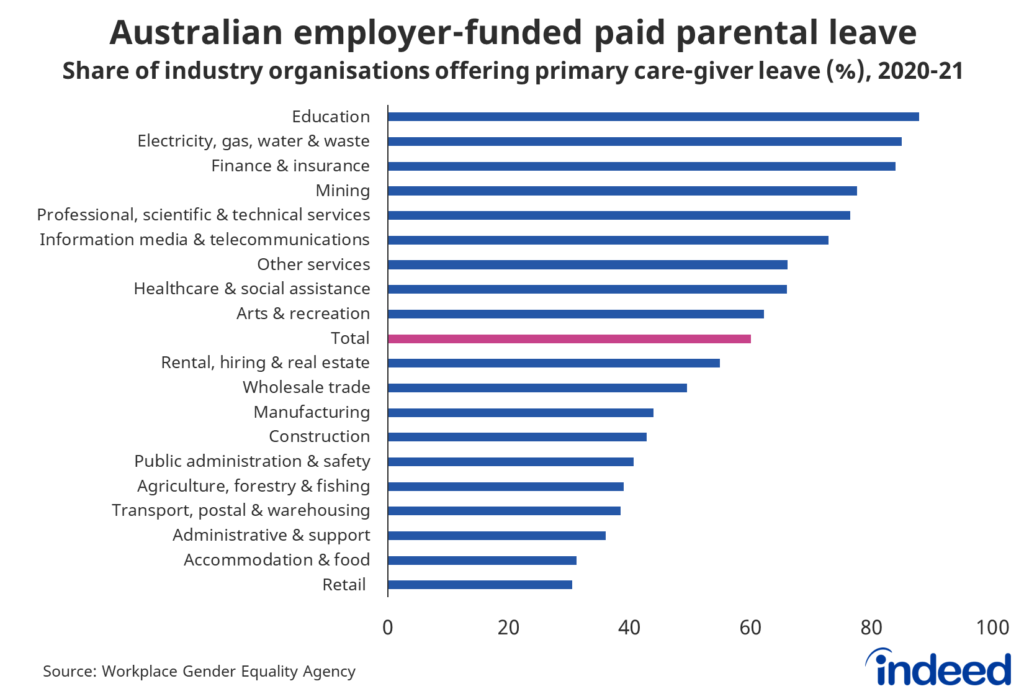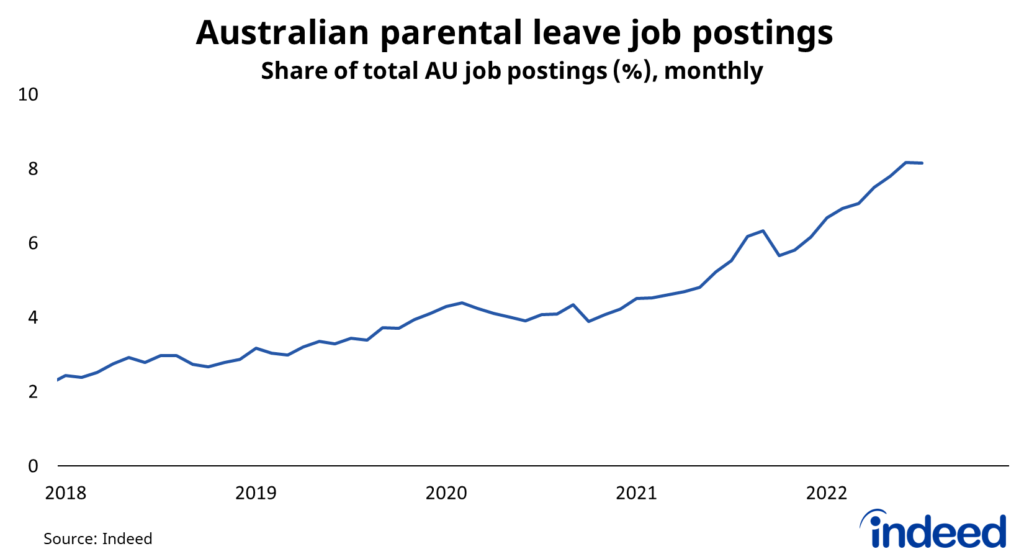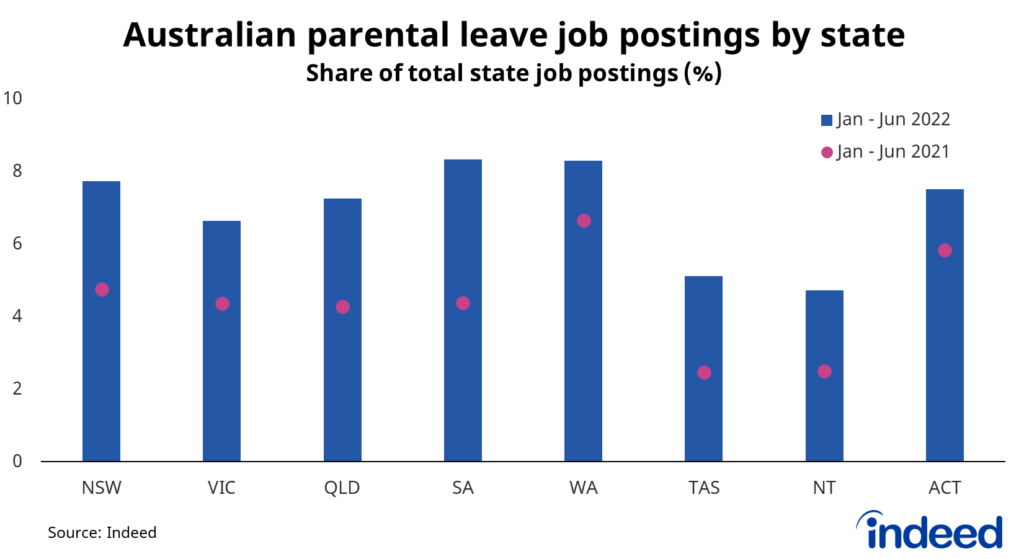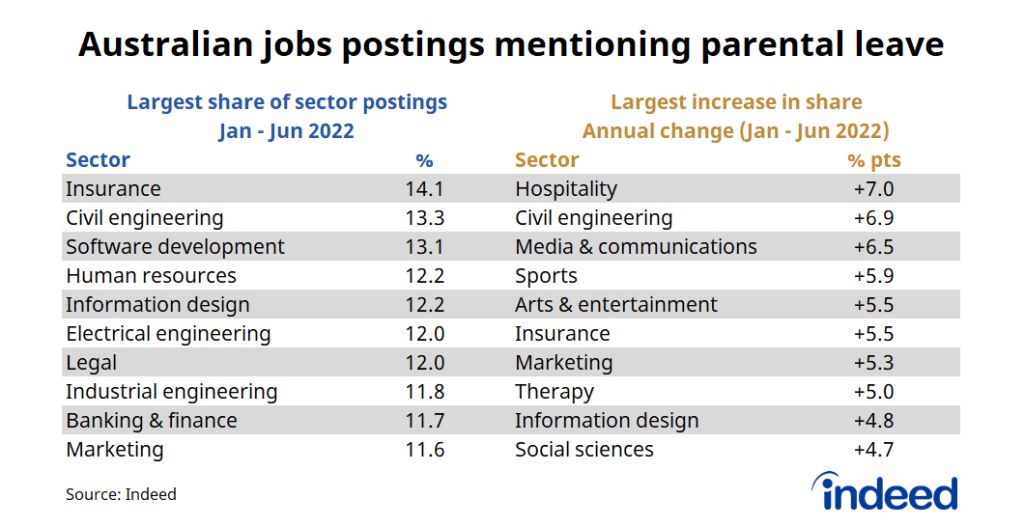Key Points
- The length of paid parental leave in Australia is relatively short by global standards, but is often supplemented by employer-funded programs.
- The availability of parental leave was noted in 7.4% of Australian job postings on Indeed in the first half of 2022, up from 4.8% during the same period a year ago.
- Parental leave references in Australian job postings are most common in a range of male- and female-dominated occupations, including engineering, human resources and marketing, reflecting provision of paid time off to both primary and secondary caregivers.
Australia has had a federal paid parental leave policy for over a decade, following its introduction by the then-LNP government led by Tony Abbott. Increasingly, private employers are supplementing the federal system and offering the benefit to both primary and secondary caregivers.
Greater emphasis on workplace flexibility, gender equality and work-life balance has raised awareness of the needs of new parents. Employer-funded leave schemes have become more generous and gender neutral, granting leave to both parents. Nonetheless, men take advantage of this benefit infrequently.
To assess the prevalence of parental leave, we tracked references to it in descriptions of jobs posted on Indeed’s Australia site. This isn’t a comprehensive measure of how many employers offer parental leave, but it does show how frequently parental leave policies are used as selling points to potential employees.
In recent years, parental leave references have increased sharply in descriptions of Australian jobs posted on Indeed. The phrase appeared 1.6 times more often in the first half of 2022 than during the same period the year before.
How paid parental leave works in Australia
Australia has two tiers of parental leave, the first federally funded and the second employer funded. The federal government’s paid parental leave scheme provides 18 weeks of time off for primary caregivers — typically mothers — at the national minimum wage. An additional two weeks of paid parental leave is granted to the secondary caregiver.
By global standards, Australia’s government-funded paid parental leave program is relatively short. In 2021, Australia ranked 29th out of 38 economically advanced countries in length of paid parental leave extended to primary caregivers. Australia’s 18 weeks of leave compared unfavourably with the 51 weeks offered on average across advanced economies globally.

However, drawing direct cross-country comparisons between parental leave systems can be difficult. For example, Australia’s system is fully funded through the tax system, requiring no additional contributions from workers. Other countries use contributions from workers or other insurance mechanisms to increase the length of leave provided to primary and secondary caregivers.
The second tier of Australia’s parental leave system involves employer-funded policies varying in length and payment amounts. In 2020-21, around 60% of Australian organisations surveyed by the Workplace Gender Equality Agency offered paid parental leave to the primary caregiver. This ranged from 88% of organisations in education to around 30% in retail trade.
The average payment length is 11 weeks, with leave typically available to both parents. Many new parents combine the federal and employer programmes to extend leave after having a child.

The Workplace Gender Equality Agency reports that parental leave schemes are becoming more gender-neutral. Increasingly, men and women are equally eligible to be designated primary caregiver. Nevertheless, only 12% of those taking parental leave were men in 2020-21.
Parental leave has gained ground during Australia’s economic recovery
References to parental leave policies have become much more common in job descriptions during Australia’s remarkable jobs recovery. In the first half of 2022, 7.4% of jobs postings on Indeed’s Australia site used phrases such as ‘parental leave’ or ‘maternity leave’ in job descriptions, up sharply from 4.8% over the same period last year. The measure peaked at 8.2% of job postings in June this year.

As competition for talent heats up, Australian employers have to find ways to to stand out. Parental leave policies have been one way to do that.
The prevalence of parental leave phrases in job postings differs by state, but their use has increased noticeably in every part of Australia. In the first half of 2022, around 8.3% of postings in South Australia and Western Australia noted parental leave policies, followed by New South Wales at 7.7%, ACT at 7.5% and Queensland at 7.2%.
In the first half of 2022, parental leave postings as a share of total postings doubled in Tasmania and almost doubled in South Australia from the year before.

Parental leave increasingly common in both male and female-dominated occupations
Indeed data show the growth in parental leave postings has been broad-based, occurring in both male and female-dominated occupations. For example, engineering, a male-dominated occupation, accounted for three of the top 10 occupations with the highest share of Indeed job postings using parental leave phrases. In the first half of 2022, 13.3% of civil engineering postings, 12% of electrical engineering postings and 11.8% of industrial engineering postings noted parental leave. This growth may reflect a desire to attract more female applicants, but could also stem from greater open-mindedness about men taking parental leave.
At the same time though, human resources and marketing, two traditionally female-dominated occupations, also had high parental leave posting shares.

Growth in parental leave postings was strongest in hospitality, with a 7 percentage point year-over-year jump. Civil engineering notched a 6.9 percentage point increase, followed by media & communications at 6.5 percentage points. Again, a mix of male and female-dominated occupations were the biggest gainers.
Men aren’t taking parental leave
Employer-funded parental leave policies are increasingly common throughout Australia, particularly among larger businesses. Leave is typically made available to both parents. These private programmes help offset the inadequacies of the federal government’s leave scheme.
The surge in use of parental leave phrases in Australian job postings on Indeed is striking. That trend is apparent in both male and female-dominated occupations, probably reflecting efforts to make parental leave policies more gender-neutral. Nonetheless, men represent only a small fraction of parental leave-takers. At the managerial level, only one in five of those on parental leave were men in 2020-21. So far, entrenched gender expectations around child rearing and care-giving have proven difficult to overcome.
That stubborn reality shouldn’t keep us from recognizing the tremendous progress that’s been made over the past decade in providing paid parental leave and extending it more equitably to both parents. For Australian employers, the next challenge is to find ways to encourage men to take advantage of this benefit more often, easing the burden women typically bear in the first months of a child’s life.
Methodology
We identify parental leave job postings on Indeed by determining whether job titles or descriptions in a post include terms such as “parental leave” or “maternity leave”.
Data on the length of paid parental leave for both primary and secondary caregivers comes directly from the Organisation for Economic Co-operation and Development (OECD).
Data on employer-funded paid parental leave comes from the Workplace Gender Equality Agency’s annual gender equality scorecard.



